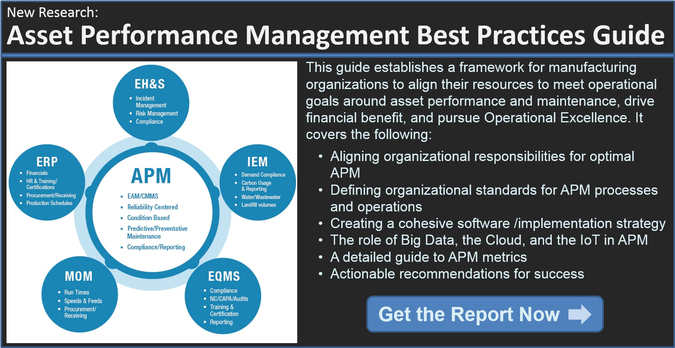Numerous previous posts have talked about the relevance of the Cloud to all aspects of manufacturing, including Asset Performance Management (APM). There is no denying that Cloud technology is radically transforming the way enterprises collect and analyze the vast volumes of data available for all of their processes.
APM is no different, the Cloud is providing new opportunities to leverage APM data so manufacturers cannot only improve their plant performance, but also potentially offer new products and services. Still, many manufacturers are concerned about moving what is often considered proprietary and sensitive information from the plant floor into the cloud.
Part of the reluctance is based on security concerns about linking the plant floor to the larger Internet in general, while another concern is over control of the data and how it might be used outside the context of improving asset performance.
This post explores the arguments both for and against moving APM data to the cloud, and identifies six questions that must be answered before taking any action.
The Cloud and Analytics
The biggest argument for moving data into the Cloud is the power of analytics. At this year's Inforum event, Charles Phillips, CEO of Infor, came right out and said that in any Cloud environment, analytics is considered a given. Likewise, SAP has made a rich analytics library part of its HANA offering. On top of this numerous vendors are now offering Cloud-based APM analytics, such as Siemens and their ePS service, or Predikto with its advanced diagnostics offering.
There are several reasons this is happening. As large vendors with broad product portfolios move their solutions to the Cloud, all kinds of data is migrating to the Cloud. CRM, Supply Chain performance, EAM, RCM, financials, and many more types of information now are stored in the Cloud. The algorithms to analyze that data evolve in each discipline differently, but then show applicability to others. This makes for a rich set of analysis tools at the engine level.
A second reason the cloud is becoming popular is that OEMs are striving to improve their product performance and one of the best ways to do that is to make it easy to collect performance and reliability data across their entire customer base, so their engineers can use that data to improve their products. Of course, analytics play an important role there as well, so that the engineers can detect systemic versus random product design issues.
Finally, the Cloud offers a powerful analysis engine with a virtually unlimited storage capacity at a relatively small cost, so decisions can be made with years of accumulated data instead of just small snapshots that might reflect a small anomaly that is not truly relevant over the course of a year or more.
Protecting Your Data in the Cloud
So with the power of moving data to the Cloud driven by analytics, but the reluctance driven by security concerns, how can a manufacturer decide when and what data to move to the Cloud?
Fortunately, many companies are addressing these issues today and precedents are being set. Early adopters are working through data ownership and use issues so that by the time most manufacturers start to seriously leverage the Cloud for APM data, many of the thorny issues will have been resolved. However, manufacturers will still need to ensure they have a clear understanding of the key aspects of having their APM data in the Cloud.
We've identified 6 questions that must be answered before moving any data to the Cloud:
- Who owns my APM data once I move it to the Cloud?
- Will my APM data be aggregated with other companies’ data?
- Will my APM data be able to be associated with me by anyone else?
- How long will my APM data remain in the Cloud?
- How can I get my APM erased from the Cloud?
- What kind of protection will my APM data have against search and seizure?
Once these questions are resolved to your satisfaction it does make sense to move your data to the Cloud. As we have pointed out before, the benefits including the opportunity to explore new business models, make better and timelier decisions, and the simple cost savings of sharing infrastructure are all drivers that make the Cloud attractive. So the answer is yes you should move APM data to the Cloud but only when you can see the benefits outweigh the risks, which will differ depending on your industry, location, and individual company operating models.
